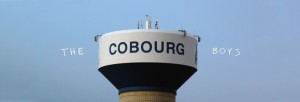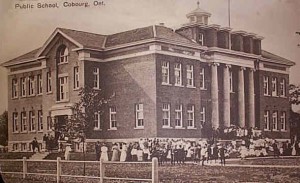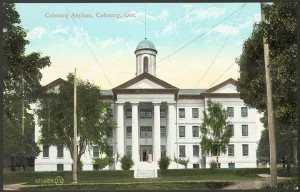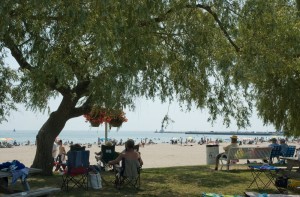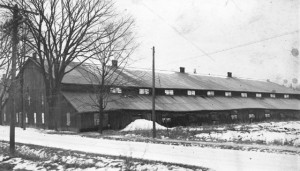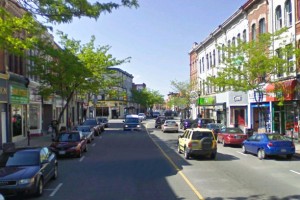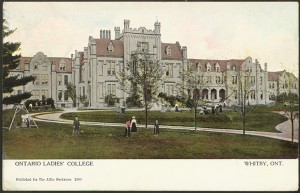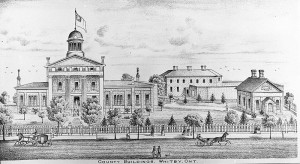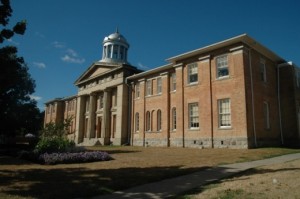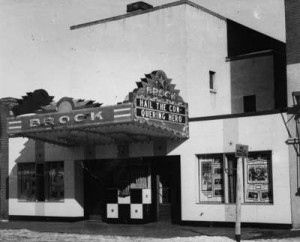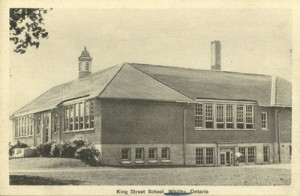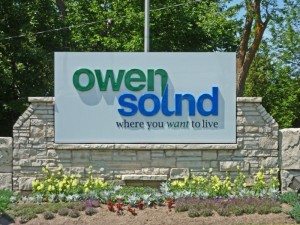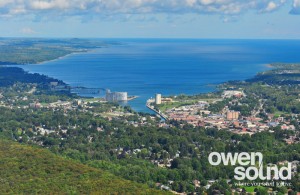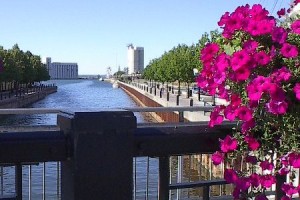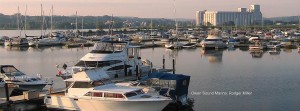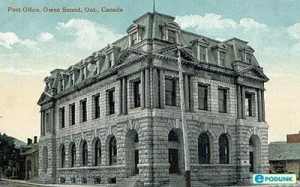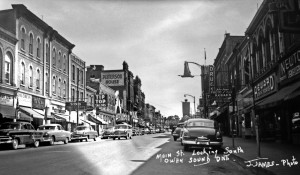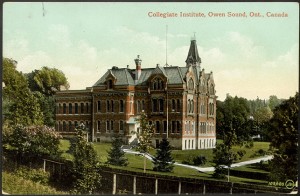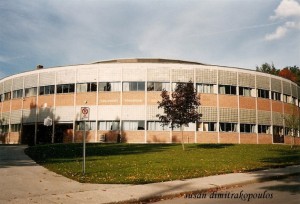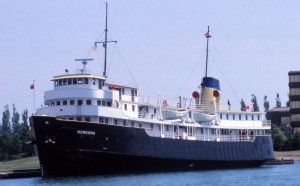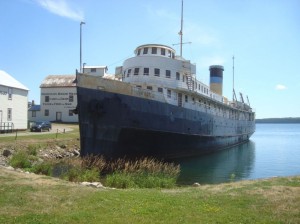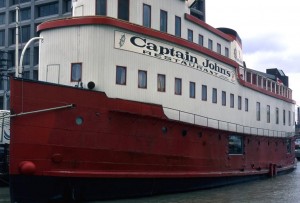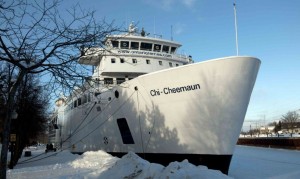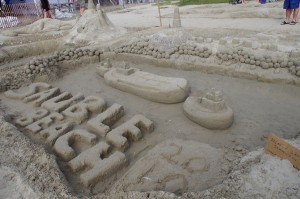Clickable Links to Bomanville, Cobourg, Whitby and Owen Sound
They say old age is all about remembering, so here goes…
Bowmanville
— I was born in Bowmanville, Ontario in 1938, in an Estate Mansion called “South Park” (c. 1855). It was to become the local hospital. Judging from the many beautifully restored 19th c. houses on tree-lined streets, Bowmanville was once very prosperous.
— Many architecturally impressive buildings of my youth have been demolished. To name just one, the Bank of Montreal where I cashed in my War Savings Stamps in 1945 (25 cents taken to school each week was big bucks in those days). The bank’s counter was way too high for me to reach and the teller was ensconced in HIS cage behind bars, so my mother handed over the goods. To the best of my recollection, I netted $8.25, which I deposited in my piggy bank.
— My only other windfalls were at the annual carnival, where the Police Department would spin a wheel and you could win a cellophane bag full of silver coins. My Dad was a good friend of the Police Chief, so the wheel always stopped at my number. One of the main industries was the Dominion Organ Piano and Co., much of which was gutted by fire the night I was born. As my father was a reporter and photographer for The Canadian Statesman, he had a busy night. My mother too.
— Bowmanville was a white bread town and if there were any residents with non Anglo names, I wasn’t aware of them. Like most small towns, everything was within walking (or tricycling) distance. We lived in a c. 1837 semi-detached house a minute from downtown. Many people rented rather than owned, or else they lived above their shops. I was able to roam around freely on my tricycle but seldom ventured more than two blocks away in any direction. The only risk was that of getting hit by a car. However, because gas was rationed, there weren’t a lot of them on the road (many were put up on blocks for the winter). I remember lots of snow in the early and mid-forties and the town roads were snow covered in winter, no salt or slush, just a bit of sand spread on top. Before people had two or three cars and lived in the ’burbs, there was a stronger sense of community. Times were simpler, but not necessarily better.
— My early years were lived at the tail-end of the Great Depression when you only bought things when you had the money to pay for them. I remember boarded-up stores. The local radio station was abandoned and its equipment vandalized. It was located where the Darlington Nuclear Plant now stands, and I can still see traces of its foundation via Google Earth.
Early Memories:
— Summer holidays at the family farm, usually at haying or harvest time, once at Christmas… and it was cold. Canada was more rural then, so I learned what it was like to work in the fields. Cold well-water on a hot day was like nothing you’ve ever tasted. Lighting was by coal oil lamp and heating by the kitchen wood stove. Electricity didn’t arrive until 1949. Telephone was by party-line and if you lifted the receiver quietly, you could learn quite a lot. The gingerbread clock chimed every hour on the hour and the chickens made a big racket every morning, but I was allowed to snooze through it all. I now have that clock on my mantel. My maternal grandfather, born in 1866, remembered a giant fire in 1869, when his father burned all the stumps that weren’t needed to build fences. My grandfather was still working in the hay mow at age 85 and when he could no longer do that he fetched in the eggs from the henhouse (I could never manage to get one out from under the hens). He died at age 95, outliving his spouse by 47 years. She had given birth to 10 children (my mother 2nd last) and life on the farm was not the easiest.
— Special dinners with my paternal grandparents, at Easter, Thanksgiving and Christmas. My grandfather had run a bakery in the 20s and 30s, in both good times and bad. When A&P opened up with bread at 5 cents a loaf, he couldn’t compete and had to close up shop. He got a job running the cafeteria at the Goodyear Tire & Rubber, so became an excellent cook.
— The local blacksmith Frank Cryderman (< Kreiderman or Kräutermann “a herbalist or pharmacist?) lived in the other side of our house had his shop across the street, so I’d watch him shoe horses. He gave this up in the 1950s as horses grew obsolete, but he continued metal-working till he was 86. During the war, milk was still delivered by horse and wagon and I was fascinated at how the horse knew the route and moved on command to the next address with no driver on board. There were still a few hitching posts in town and I used to hang out near the cast-iron water fountain mounted on concrete in front of the Cenotaph. It had three troughs. Horses drank out of one side, people out of the other, while dogs and cats had their own basin on the people’s side. Hygiene had not yet been invented. I recently revisited this artifact at the Bowmanville Museum, a few doors away from where we used to live.
— Milk was left at your doorstep and in the winter the cream on top would freeze and lift the bottle cap 3 or 4 inches high. Heating was mostly by coal, which meant that buildings got blacker than originally intended. Refrigeration was by ice-box and when the iceman came round, he’d give us kids some ice-chips to savour; these came directly from the lake, but we had no worries as pollution had yet to be invented.
— Measles, mumps and chicken pox were rampant, so we got our immunity from Mother Nature. You would see 30- to 45-day quarantine signs posted on people’s front doors. Today, any seniors who once had chicken pox should get the shingles vaccine.
Entertainment & Diversions:
— Mostly playing with friends. The Royal Theatre was a hop-skip-and-jump away, but I wasn’t allowed to go. The matinees — Westerns in black and white — must have been really good because the kids would scream with delight when the feature began. My Mom made up for this by taking me twice to Oshawa’s Regent Theatre where — in living Technicolour — we saw Bambi and then Snow-White and the Seven Dwarfs. The Sorcerer’s Apprentice scene was definitely the scariest.
— Television development was interrupted by the war so radio was king. My favourite show was on CFRB: Santa Claus from Eaton’s Toyland. I was the saddest kid on the block when Santa signed off for the last time on Christmas Eve. Baby Snooks and “Just Mary” were close runners-up. Right after Santa came Jim Hunter with the evening news (Theme: “A Hunting We Will Go”). He was succeeded, I think, by Jack Dennett, then by Gordon Sinclair. Endless commercials, mass marketing and “race-to-the-bottom-talk-radio” had not yet been invented (Praise the Lord for small mercies!).
— I started taking piano lessons when I was about four. Though I didn’t become the second Chopin, a love of music remains. Mozart is still the greatest: simplicity, precision and boundless energy. How anyone could accomplish so much in 35 years is beyond me.
— On Sundays my dad would take me to the beach, which is now part of the Darlington Nuclear property. Or else we went to the Cream of Barley Camp, where they had swings and slides plus the odd rabbit and raccoon. Today it’s the Bowmanville Zoo and you pay admission to get in. In winter, we would go sledding down the giant hill at Vanstone’s Mill, Bowmanville’s original power source. Once I ended up with my head planted in the snow and my feet flailing in the air, but was promptly rescued.
— Often we would go to the CPR Station to watch the passengers and freight being loaded while the locomotive took on water. Trains don’t stop there any more. King George and Queen Elizabeth made a whistle stop in 1939 to ramp up patriotism for the impending war, but I was too young to remember it. In fact, we weren’t told much about the war. My Dad gave up his job at the Canadian Statesman to go to work at the Ajax Munitions Plant (Defense Industries Ltd). He had a black 1930s McLaughlin Buick with a gas ration sticker on the windshield and a rack on the back for a (non existent) trunk. It must have been furnished to him to take workers to Ajax everyday as we wouldn’t have had the money to buy it. Smoking at the plant was strictly forbidden because of the explosives, but legend has it that workers crawled under the pre-fab buildings to light up.
— The war gave the British Empire a extended raison d’être. I remember hundreds of Union Jacks flying every 24th of May. Military parades with bands too and I loved to march alongside them. One day, a parade passed our house and they were torching a man on a float. Was I scared! My Mom said it wasn’t a real person, just an effigy of a bad man called Hitler. My only other scare was the day my Dad didn’t return home. He’d been called to Kingston to report for military service. Fortunately he was exempted, probably due to his work at Ajax.
— I have a clear recollection of the war’s end. It had been raining most of the day, but after dinner the sun came out and church bells everywhere started ringing their hearts out. More people than I’d ever seen in my life came out of their houses and walked on the streets. Quite the spectacle… and quite the sense of relief.
Images & Web References for Bowmanville:
Row #1: “South Park”, the hospital where I was born and my first school, Central Public, 125 years old in 2014. In 1945, my grade 1 class was on the extreme left, first floor.
Row #2: My street, Silver Street, looking north to the school.
Row #3: The Dominion Organ & Piano Company; the Post Office and Bank of Montreal, where I cashed in my War Savings Stamps for $8.25
Row #4: Bowmanville Harbour & Vanstone’s Grist Mill, still there but no longer with its original raison d’être
Row #5: Defense Industries Ltd: The Ajax Munitions Plant in Wartime
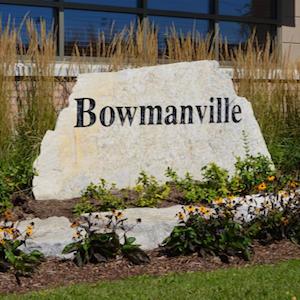
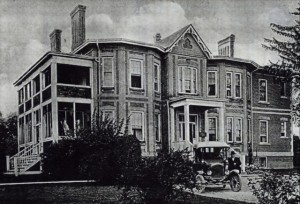

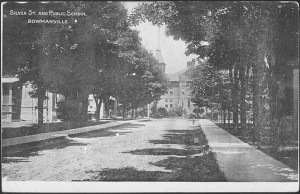
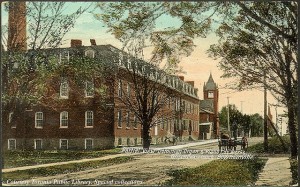
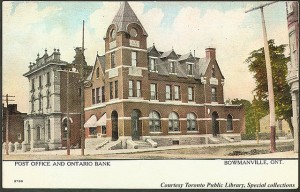

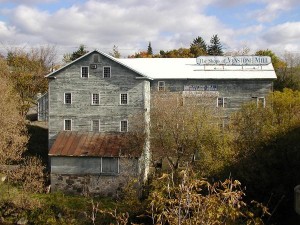
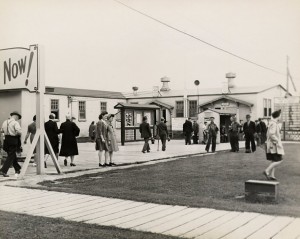
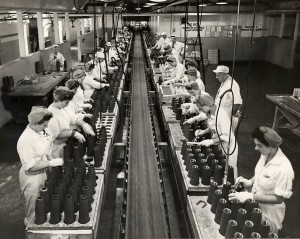
Wikipedia’s Bowmanville
Images for Bowmanville
Bowmanville Zoo
Central Public School
Cobourg
— In 1946, my Dad got a job as Jack-of-all-Trades at the Cobourg Sentinel-Star. My Mom put me on a bus all alone to go to our new town. It said “Gananoque” on the front, so I thought I would end up there for sure. But Mom asked a stranger in the next seat to make sure I got to the right destination… and I did.
— We lived in a large rental house with a wrap-around veranda on about an acre of land with an abandoned orchard and a little creek with tadpoles in the back yard. Today, the orchard is “affordable apartments and a parking lot” and the creek is a ditch. We were close to the CPR station, so I’d often be awakened by the roar of passing trains. Via Rail now has computerized passenger lists, so the trains stop only where passengers need to embark or disembark. We must have been on the Toronto-Montreal flight path because Trans-Canada Airlines flew extra noisy propeller planes overhead. The Cobourg house built in 1874 was a bit down at the heels. Today it looks great and sports a heritage designation. We had oil-fired space heaters for the bleak of winter and there was no bathroom. Mr. Edey the carpenter soon installed one so I never had to use the privy out back. Baths were taken in a portable metal tub near the kitchen wood stove. Our rent was $35 a month.
— Little did I imagine that, some 50 years later, and not yet in my complete dotage, I would be consigning antique Canadiana furniture to the Cobourg Antique Mall, a mere block away from our former residence.
— I attended George Street Public School for grades 2 through 4. Today it has a new lease on life as upscale condos. Once my Mom and I played Bingo at a carnival on the school grounds. Five of my chips lined up in a row, but I was too chicken to yell BINGO! Mom piped up and we won a lamp that still does duty to this day.
— Cobourg once hoped to become Canada’s National Capital, hence the Victoria Hall (designed by architect Kivas Tully) that dominates the centre of town (Municipal Building and original Courthouse, with the jail close at hand). Also the original Victoria College (1835), first known as the Upper Canada Academy, is located at the intersection of College Street and University Avenue. Today, it is a Seniors’ Residence, but in our time, it was local “The Mental Hospital”. Its once extensive grounds are now chock full of condos. Also the beautiful Victoria Park with a great sandy beach and Sunday concerts at the bandshell.
— Cobourg was once linked to Rochester by two large ferries, the Ontario No. 1 and No. 2. We would watch the train cars being loaded on board and wave to the passengers as the ships departed. Cobourg was a summer destination for wealthy folks from Rochester and the Shiners would come to town once a year to let off steam and hold their annual parade. The harbour that was once a large coal yard is now a Marina surrounded by upscale condos. When travelling that way, I park my car on the pier that juts far out into the lake, have my lunch, and watch the freighters pass in the distance.
— During our time in Cobourg, my mother began to have symptoms that were, in retrospect, consistent with depression. In the early 30s, she had been in charge of a one-room country school with Grades 1 to 8. According to the Inspector’s Report, she did a fine job of controlling the unruly kids “despite her small stature”. However, during the Depression, women had to give up their jobs after a 5-year stint, get some additional education and/or get married. In this way, another poor soul could earn a living. Thus were women “liberated” from the workplace and “freed” to produce a family. I imagine that losing the challenge of a career contributed to my mother’s depression. However, she put her teaching skills to good use raising three children. In 1948, we moved on to Whitby.
Images & Web References for Cobourg:
Row #1: Main Street gentrified
Row #2: My second school, George Street Public & the Original Victoria College (1836)
Row #3: The Beach at Victoria Park, then and now
Row #4: Cobourg Harbour, ca. 1950 (note the two car ferries) and as a Marina (2014)
Row #5: Two views of Victoria Hall

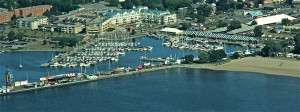
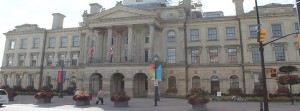
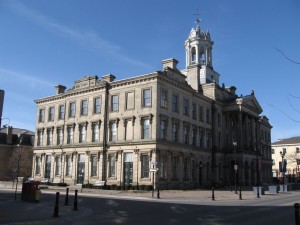
Wikipedia’s Cobourg
Images for C0bourg
Victoria Hall
My Old School, now Mansions on George St.
The Original Victoria College
Whitby
— I was 10 in 1948, when we moved to Whitby. At the time, its population was less than 8000 (now 122,000 and growing). Many streets were unpaved with ditches on either side. My parents bought their first home, a small, pre-war, two-bedroom bungalow. By that time, my younger sister Carol had arrived, so they built me a room in the basement, where I lived for the next 8 years. I must have been the first child to live in his parents’ basement, while I saved up for an education and a mortgage of my own. My dad’s employer provided him with a car, a black 1948 Chevrolet with standard transmission, on which I learned to drive. Mind you, I had also been allowed to steer a 1938 Pontiac in my earlier years, but my feet wouldn’t reach the pedals. I took my driver’s test in 1954, on the stroke of 16. Flashing lights had yet to be invented, so hand-signals were required to indicate your change of direction. So when I failed to signal a turn, the examiner asked me why. My answer: “There was nobody around to signal to!”. I must have convinced him because I got my license, no problem. They should be so forgiving at age 80!
— When I was 11, I got my first job as a carrier for the Oshawa Times-Gazette (no CV required as Dad was the local editor and reporter). My route was easy, except in winters when my bike and I sometimes had to be rescued from the deepening snow. Besides a steady income, the principal side-benefit was the annual paper carrier contest: Sign up 15 new subscribers and you win a free trip. In my first year, I reeled in only 8 fish (too timid). In the ensuing years (1950-1952), I landed the required 15 or more subscriptions and won trips to Buffalo (a vaguely sinful destination for Torontonians), Montreal (at that time the New York of Canada) and Ottawa (then Canada’s capital, now my preferred cycling venue).
— Other jobs included cutting grass with old reel mowers, generously provided by homeowners who were too lazy to push them. As a young entrepreneur, I sold Freshie at the local ball park (5 or 10 cents a cup and somewhat less than a beer today at the Air Canada Centre). I raised enough money to help build a grand swimming pool (since bulldozed) at the Kinsmen’s Park. Then I moved on to the local Fish & Chip emporium, where I produced all the chips for several years and waited tables. We were located near the Royal Hotel and beverage parlour, so at closing time (5:30 as I recall), tipsy folks would come in for a sobering bite to eat before heading home. On one memorable occasion, a patron fell asleep with his head resting on his plate of fish and chips…, comfort food at its finest! Then I moved to Allin’s Drugstore where I stocked shelves and decided not to become a pharmacist.
— I also joined the choir of St. Mark’s United Church, directed by a multi-talented woman name Kathleen Rowe (née Leask). As well as directing the choir, she was the Church organist. She also taught music in all of Whitby’s primary schools. In addition, she was Musical Director of the annual Minstrel Show, in which I participated. That was before people realized that such shows were demeaning to blacks. She died young of cancer, but the community held her in such esteem that Kathleen Rowe Memorial Public School was named after her. Let no one tell you that music is not an important part of the curriculum. Language and Mathematics may develop your rational mind, but Music takes you beyond it.
— One day, the mirrors in the Fish and Chips shop began to rattle ominously and my boss told me to get home as soon as I could. Hurricane Hazel was about to arrive (October 15, 1954), and I don’t mean the mayor of Mississauga. My Dad was the local news editor and the power went out, so we jumped in the car and drove around to see what was happening. Trees and power lines were coming down everywhere, the wind was furious and the lake was in a frenzy. Guess my father thought it would be a good idea to return home, but that was a challenge because trees, branches and flooding now impacted the roads we had travelled just a few minutes earlier. Definitely the craziest weather I’ve ever seen.
— When I reached grade 7, my interest in school grew keener, thanks in large part to an excellent teacher, Mrs. Carrie Arksey, who was both demanding and encouraging. In Grade 8, a highlight was Mr. Breckenridge’s shop class, where I learned basic woodworking. I still have three items that I made there, a game-puzzle, a fancy tray and a knick-knack shelf. School was pretty easy then, and there was very little homework. Language and grammar were favourite subjects, understandably so since mother had been a teacher and my father was a journalist.
— The first English words I had learned to read were “The Toronto Daily Star”, a newspaper for which I still have great respect, though no mere mortal is capable of digesting the complete Saturday Edition. My first awareness of language came when I asked my Mom about the words I couldn’t understand on a can of “Carnation Evaporated Milk”. They were French and she told me what they meant. Such were my linguistic points of departure. I came to believe that errors of language, or of spelling were akin to mortal sins. Thus, when much later I suffered a mini-stroke that played tricks with my spelling and morphology, I felt much troubled. However, my brain has forged new circuits, and my Spellchecker also helps
— I was generally attentive and well-behaved at school but one day when I was feeling extra frisky, I got a detention (my one and only). The charge was “making animal noises in class” (cats, dogs, chickens, sheep, wolves, etc.). I pled guilty and received a dressing down from the principal, plus 30 minutes in custody. The guards must have busy supervising more interesting activities because no one came to release me at the end of my half-hour. So I just walked out. Though I do not list this particular skill-set on my CV, I have put it to good use on occasions when the vibes were right. I once attracted a large crowd at the National Art Gallery (Ottawa) by making animal noises into a giant megaphone (it had been created by the Mohawks for use during the Oka Crisis in 1990). When such prestigious venues are unavailable, underground tunnels make great sound chambers (there’s a good one near MacKenzie-King’s Estate in Gatineau Park, another one no longer accessible between the Ross Building and Founders College and Vanier). As a postscript, I should add that the principal who sentenced me to 30 minutes (God rest his soul) was subsequently relieved of his duties for an offense more serious than making animal noises in class.
Images & Web References for Whitby:
Row #1: Ernie Taylor’s Arena, as it was in my youth
Row #2: View’s of my street, Brock Street
Row #3: Ontario Ladies’ College (Trafalgar Castle), where I took piano lessons & Interior of Saint Mark’s Church, where I sang in the choir
Row #4: Views of the County Courthouse, Registry Office & Jail
Row #5: The Brock Theatre, where I took my first date; My third school (King Street Public, later R. A. Sennett, built 1922, closed 2010)
Row #6: The Royal Hotel, then and now. Men frequented its beer parlour before dropping in to nearby Hurley’s Restaurant for fish and chips.
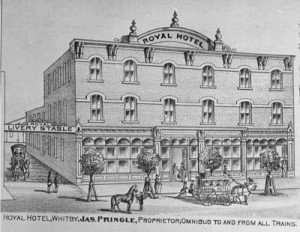
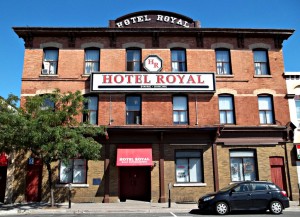
Wikipedia’s Whitby
Images for Whitby
Owen Sound
— In winter 1956, we moved to Owen Sound, where my Dad found employment as Telegraph Editor at the Sun-Times. I was sad to leave Whitby as I had made close friends there and put down roots. Owen Sound had a vibrant downtown with countless barber shops and churches. The town was laid out with numbered “avenues” running north/south and “streets” running east/west, so it was hard to get lost. TV was available, but the only station we could get was Wingham. As a result, four movie theatres still flourished, but now they are long gone. Recently, I saw a set of seats from the Roxy Theatre being auctioned off in Creemore. At the Centre Theatre, I remember seeing Charlie Chaplin’s “Modern Times” and laughing till it hurt. The high school crowd was rather cliquey, all the kids having their established networks and friends. However, I met my first girlfriend through the school choir and we established a clique of our own.
— I finished grade 12 and did my grade 13 there and have some live memories: Singing “Stand and Sing for the OSCVI” in the circular “salmon-can” auditorium. Hearing Choirmaster Edouard Bartlett make the violin sing as I had never thought possible. The school still had a quasi-military Cadets programme that nobody liked. I think it was abandoned shortly after. I joined the Radio Club, and did a weekly events and comedy hour on CFOS. Though it was a lot of fun, I eliminated radio as a possible career…, too much fast-talking and too many commercials…, yes even then. I did enough homework to pass my exams and get admitted to the University of Toronto in 1957.
— In summer 1958, I was hired as a waiter (later Headwaiter) on the SS Norgoma, which plied Georgian Bay, the North Channel and Whitefish Bay. This lasted until 1963, when it was converted to use as a ferry on the Tobermory-South Bay Mouth run. Working as a waiter allowed me to pay my way through university without parental support. Try to do that today! We received $35. a week in salary, but most of our income was derived from tips. Many generous Canadians and New Yorkers topped up our modest incomes. Saturday and Monday afternoons were shore leave, the sunny days spent at Sauble Beach. These were my happiest and most carefree times. As proof of this claim, I met my future wife Betty on a romantic five-day cruise on the Norgoma.
— Today, that ship serves as a museum in the port of Sault Ste. Marie. However, but its retirement is in jeopardy because it is outliving its meagre income. It’s sister ship, the SS Normac, became Captain John’s restaurant at the foot of Bay Street until it was struck and sunk by the Trillium. The Norisle, another ferry that linked Tobermory to South Bay Mouth, was replaced by a larger vessel, the MS Chi-Cheemaun. On our travels, we would often encounter the SS Keewatin from Port McNicoll (now a museum ship), the SS North American and the SS South American (both from Chicago).
— In 1957 I began university with an interest in language — both English and French — expecting to become a High School teacher. To the consternation of the Registrar of Victoria College, I changed from the Honours programme in “Soc & Phil” to General Arts, graduating a year early in 1960. Then it was off to France for a year as an Assistant de langue anglaise at the École normale d’Instituteurs located at Poitiers, the city of all the ages, with the notable exception of the 20th century. It was near Poitiers that Charles Martel decisively repulsed the Muslim advance from Spain, in 732 or 733 AD. This was an early episode in the rivalry between Islam and Christianity. Much of my academic year was spent at the Café de la Paix, an unofficial branch of the Faculté des Lettres. But that’s another story.
Images and Web References for Owen Sound
Row #1: The Sound & Harbour
Row#2: The Harbour Today
Row #3: The Old Federal Building and Main Street
Row #4: An Owen Sound Winter (Seldon House on the right)
Row #5: The OSCVI (ancient and modern)
Row #6: The SS Norgoma and SS Norisle
Row #7: The MS Normac in its Heyday
Row #8: The Normac sunk by the Trillium; The Chi-Chimaun replaces all of the preceding
Row #9: Inglis Falls and the sand that gave its name to Sauble Beach
Row #10: Far from the “Madding Crowd”
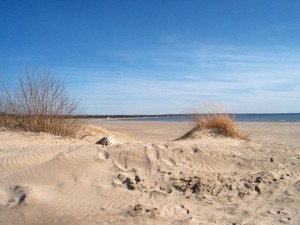
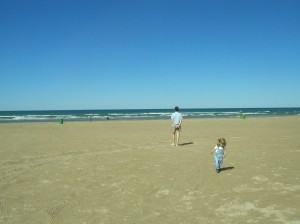
City of Owen Sound
Wikipedia’s Owen Sound
History of the SS Norgoma
Norgoma Supporters
Wikipedia’s Norgoma
The Norgoma in Jeopardy
Images for Owen Sound
Images for Sauble Beach

